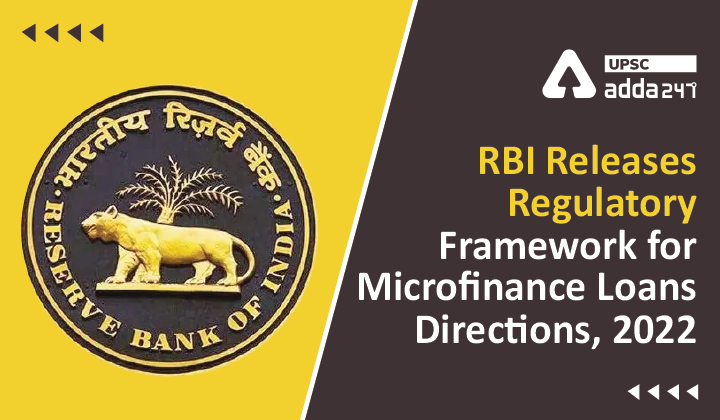Table of Contents
Microfinance Loans: Relevance
- GS 3: Indian Economy and issues relating to planning, mobilization, of resources, growth, development and employment.
Microfinance Loans: Context
- Recently, RBI has put in place the directions for microfinance loans to make credit available to low-income households in a transparent manner while ensuring borrowers’ protection from any sharp practices adopted by the lenders.
Microfinance Loans: Key points
- The Reserve Bank of India (Regulatory Framework for Microfinance Loans) Directions, 2022 will be effective from April 01, 2022.
What is a microfinance loan?
- A microfinance loan is defined as a collateral-free loan given to a household having annual household income up to ₹3,00,000.
Microfinance Loans Guidelines
- The RBI has asked regulated entities (REs) lending to the microfinance segment to ensure that loans are collateral-free and not linked with a lien on the borrower’s deposit account.
- The regulated entities involves all Commercial Banks (excluding payment banks); All Primary (Urban) Co-operative Banks/ State Co-operative Banks/ District Central Co-operative Banks; and All Non-Banking Financial Companies (including Microfinance Institutions and Housing Finance Companies).
- According to the directions, REs shall have a board-approved policy to provide flexibility of repayment periodicity on microfinance loans in line with the borrowers’ requirement.
- RBI has also done away with the margin caps that were specifically applicable to non-banking finance company–microfinance institutions (NBFC-MFIs), to bring harmonisation of the regulatory framework.
Loan pricing
- The margin caps (not exceeding 10 per cent for large MFIs with loan portfolios exceeding Rs 100 crore and 12 per cent for the others) are no longer applicable to NBFC-MFIs.
- Each RE shall put in place a board-approved policy regarding pricing of microfinance loans.
- Interest rates and other charges/ fees on microfinance loans should not be usurious. These shall be subjected to supervisory scrutiny by the RBI.
- There shall be no pre-payment penalty on microfinance loans. Penalty, if any, for delayed payment shall be applied on the overdue amount and not on the entire loan amount.
Cap on loan repayment
- RBI has prescribed a limit on loan repayment obligations of a household.
- The outflows, capped at 50 per cent of the monthly household income, shall include repayments (including both principal as well as interest component) towards all existing loans as well as loans under consideration.
- Existing loans, for which outflows on account of repayment of monthly loan obligations of a household as a percentage of the monthly household income exceeds the limit of 50 per cent, shall be allowed to mature.
- However, in such cases, no new loans shall be provided to these households till the prescribed limit of 50 per cent is complied with.
Loan card
Each RE shall provide a loan card to the borrower which shall incorporate the following:
- Information which adequately identifies the borrower;
- Simplified factsheet on pricing;
- All other terms and conditions attached to the loan;
- Acknowledgements by the RE of all repayments including instalments received and the final discharge; and
- Details of the grievance redressal system, including the name and contact number of the nodal officer of the RE.
Outsourced activities
- RBI said that outsourcing of any activity by the RE does not diminish its obligations and the onus of compliance with these directions shall rest solely with the RE.
- A declaration that the RE shall be accountable for inappropriate behaviour by its employees or employees of the outsourced agency and shall provide timely grievance redressal, shall be made in the loan agreement.
Recovery of loans
- Each RE shall put in place a mechanism for identification of the borrowers facing repayment related difficulties, engagement with such borrowers and providing them necessary guidance about the recourse available.
- Recovery shall be made at a designated/ central designated place decided mutually by the borrower and the RE. However, field staff shall be allowed to make recovery at the place of residence or work of the borrower if the borrower fails to appear at the designated/ central designated place on two or more successive occasions.
- RE or its agent shall not engage in any harsh methods towards recovery.
Qualifying Assets criteria
- The minimum requirement of microfinance loans for NBFC-MFIs also stands revised to 75 per cent of the total assets.
- The definition of ‘qualifying assets’ of NBFC-MFIs is now being aligned with the definition of ‘microfinance loan’.
- The maximum limit on microfinance loans for NBFCs (i.e., NBFCs other than NBFC-MFIs) now stands revised to 25 per cent of the total assets.
- Under the earlier guidelines, an NBFC that does not qualify as an NBFC-MFI, cannot extend microfinance loans exceeding 10 per cent of its total assets.
Read current affairs for UPSC





 TSPSC Group 1 Question Paper 2024, Downl...
TSPSC Group 1 Question Paper 2024, Downl...
 TSPSC Group 1 Answer key 2024 Out, Downl...
TSPSC Group 1 Answer key 2024 Out, Downl...
 UPSC Prelims 2024 Question Paper, Downlo...
UPSC Prelims 2024 Question Paper, Downlo...





